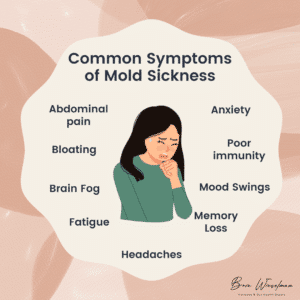Did you know you might have an unwanted house guest?
Sometimes, that “guest” sends out a musty odor, so you know it’s there.
Other times, there are no obvious signs of your visitor’s presence.
In fact, the problem may not have originated in your current home. Your unwanted visitor might have hitched a ride with you when you moved from one place to another.
This visitor is a real troublemaker.
I’m talking about mold. Gross, right? Especially when you discover that it can colonize more than just your house—it can also colonize you.
Mold can wreak havoc on your health. If you suffer from brain fog, fatigue, acne, light sensitivity, sleep problems, or headaches—or one or more of the other symptoms listed later in this article—your unwanted guest could be to blame.
When mold makes you sick, it’s called mold toxicity, mold illness, or mycotoxin illness.
My Personal Experience with Mold
I’m deeply interested in mold toxicity right now. Why? During a recent storm, my neighbor’s hose froze and ruptured. The trouble began when it thawed out, and the water saturated the ground between our homes. Some of that water leaked into my basement—an area already susceptible to mold because it’s foundation is 100 years old.
I woke up on Christmas morning to the sound of water trickling in the basement and spent the day shop-vacuuming up over 30 gallons of water as it flowed down the inside of the dry wall and out across the flooring (and under it!) from under the baseboard. A demo team came pretty quickly to remove the Pergo and linoleum, and parts of the drywall– the bigger problem was that once those were pulled out, there was clear evidence of pre-existing water damage and mold on the surfaces. I immediately had an industrial grade HEPA air filter installed to vent the basement air to the outside as a temporary solution until I could get all the mold removed.
Uh, oh! It was clearly time to take aggressive action or my health, and that of my family, could suffer.
I plan to run mycotoxin testing on myself and journal the results, so stay tuned for updates on my progress. For now, let’s talk about mycotoxin illness and how it may impact your health.
What Is Mold Illness?
Mold is a fungus that’s usually found outdoors, but sometimes it can lurk in your home, office, or even your car or child’s school. When mold invades a water-damaged indoor area, watch out! It can cause mold illness, and you may dismiss the symptoms without realizing they’re causing many of your most bothersome health problems.
Buildings aren’t the only source of mold exposure, though. Did you know that mold can grow inside breast implants in some women?
Mold releases odorless mycotoxins into the air, which can really do a number on your health. Exposure to mycotoxins can cause mold toxicity, also known as mycotoxin illness or mold illness.
Likewise, mold creates other troublemakers known as volatile organic compounds (VOCs). If you notice a musty odor in a water-damaged area, these VOCs are to blame. And if you can smell them—and even when you can’t—you can inhale or swallow them. In some cases, mold can colonize your body, causing you to pump out mycotoxins from within.
Exposure to mycotoxins can trigger chronic inflammatory response syndrome—CIRS, for short. CIRS kickstarts excessive inflammation, which can impact pretty much any organ in the body. CIRS symptoms are the same as those caused by mycotoxins since CIRS is often the culprit behind mold toxicity.
Even in small amounts, mycotoxins and VOCs can harm the body. In fact, they’re considered carcinogens. They create a high level of damaging oxidative stress, which in turn harms the mitochondria of your cells. Think of mitochondria as the powerplant of your cells that fuel your body with energy. If you have a hard time getting out of bed in the morning and are dragging all day, your mitochondria could need some tender loving care.
It’s important to remember that mold toxicity and mold allergy are completely different things. During mold allergies, your immune system reacts to mold spores. The result? A runny nose and itchy, watery eyes, etc.
Mold toxicity often affects more than just your sinuses and lungs, and it causes symptoms that can be mistakenly attributed to some other trigger.
Symptoms of Mold Sickness
Different types of mycotoxins can each cause specific symptoms. For example, the mycotoxin ochratoxin A leads to problems with brain or nerve function and may cause nerve pain or a hormone imbalance. This mycotoxin also attacks your immune system.
Whether or not you feel ill varies greatly. Even in the same environment, you may feel sick while your coworker or spouse feels just fine.
So, what causes those reactions? You can thank your genes for an increased vulnerability to mold. Nearly 25% of people living in the U.S. are genetically susceptible to mold toxicity. If you’re one of them, your immune system doesn’t identify and eliminate the mycotoxins as easily as other people’s systems do, so the toxins build up in your body.
There are more than 100 mold illness symptoms. I can’t list all of them here, but some of the most common ones include:
- Abdominal pain
- Anxiety
- Asthma (new-onset or worsening)
- Autoimmune disorders
- Bloating
- Brain fog
- Chemical sensitivity (symptoms that occur when exposed to chemicals or fragrances)
- Depression
- Diarrhea
- Digestive problems, like irritable bowel syndrome (IBS)
- Dizziness
- Fatigue
- Headaches
- Irritability
- Joint pain or stiffness
- Leaky gut
- Memory loss
- Mood swings
- Muscle pain
- Nausea and vomiting
- Poor immunity
- Sensitivity to bright light
- Sinus problems
- Skin irritation or rashes
- Skin sensitivity, even to light touch
- Sleep problems or night sweats
- Sore throat
- Thyroid problems
- Tremors
- Urinary incontinence
- Weight gain
Your Brain on Mycotoxins
Ochratoxin, the most common mold mycotoxin, greatly reduces dopamine levels, especially in areas of the brain linked to Parkinson’s disease. In addition to Parkinson’s disease, over time, mold toxicity puts you at risk for:
- Alzheimer’s disease
- Amyotrophic lateral sclerosis (ALS, also known as Lou Gehrig’s disease)
- Autism
- Multiple sclerosis
Tests for Mold Exposure
Just because you don’t live in a warm, humid part of the world doesn’t mean your home is safe from the problem. Mold can occur anywhere. Studies show that half of the buildings in North America may have water damage.
If you have mold toxicity symptoms, don’t write them off because your house is a new build or you can’t smell anything musty. Testing for mold is your best bet.
Because mold can also colonize your body—and especially your gastrointestinal tract—the problem might not even be in your current residence or office. Your previous home or workplace could be to blame. Mold can catch a ride on things like papers, books, and even your clothes. This means it can travel with you from place to place.
Here’s how to test your home for mold: use a do-it-yourself (DIY) mold testing kit, such as this one as a starting place. Want another option? Use a professional home inspector. I love We Inspect, but you can also find mold testing professionals in your area through the National Association of Mold Remediators and Inspectors (NAMRI).
You can also work with a functional medicine provider who will use a mold toxicity urine or stool test to detect the presence of mycotoxins in your body and help you create a personalized protocol to remove them.
Treating Mold Toxicity
Once you’re certain that you’ve been exposed to mold, how do you kick mold illness to the curb? I use this five-step approach:
- Ditch mold exposure either by moving or thoroughly treating and/or revamping your home or office. If you move, be careful what you bring with you. Mold can contaminate furniture, documents, books/bindings, clothing, and fabric.
- Have your functional medicine provider order baseline mycotoxin urine, and sinus testing to gauge your level of exposure. Stool testing for fungal dysbiosis is also encouraged. Your provider can recommend natural antifungals to kill any mold colonizing the GI tract, lungs, or sinuses.
- After six weeks of treatment, your functional medicine provider should retest your mycotoxin levels. If mycotoxins are still present, you may need to try a new antifungal treatment or increase the dosage.
- Help the body chase away the mycotoxins. Using natural binders and using products to boost bile production can help pull mycotoxins out of the body. Liposomal glutathione is a great choice for removing residual mycotoxins. Mold toxicity seriously decreases glutathione levels. As your body’s major antioxidant, glutathione fights the oxidative stress caused by mold. In some cases, you might need to sweat the mold toxins out of your body using an infrared sauna or sauna blanket. Be sure to hydrate and poop one to three times per day.
- Support your mitochondria and energy as well as insulin levels and hormone balance.
Feel Better by Fighting Off Fungus
Is mold toxicity causing your sickness, fatigue, or other health problems? As a functional medicine provider, I’ll find out the answer to that question. The process begins with a free 15-minute troubleshooting call. From there, I can order the right mold toxicity tests and interpret the results to find out whether we need to take steps to get rid of your mold exposure and treat your mold illness. I’ll develop a treatment plan to help you feel more energetic, clear-headed, and better overall. Sign up for a call today, so you can feel like your old self again.
At the Reverse-Age Method, we believe in a holistic approach to perimenopause and beyond, that addresses the root causes of your symptoms (like insomnia, hot flashes, night sweats, erratic periods, fatigue, skin aging, weight gain, and brain fog)– to also slow the pace that your cells are aging. Whether it’s improving gut health, optimizing detox function, enhancing mitochondrial function, or building muscle mass, our comprehensive program has got you covered.
If you’re new here, be sure to check out our Blog Page for more insights and tips on how to thrive during perimenopause. Our blog is packed with practical advice, success stories, and the latest research to help you on your journey.
For more updates and community support, follow us on social media:
You May Also Like...
All About Food Sensitivities – New Cutting Edge Test Available! (KMBO FIT Test)
One of the primary tenants of Functional Medicine is to identify triggers for inflammation and reduce exposure.…
Take control of How You Age With the Reverse-Age Method Program
Age may be just a number, but who says it has to be YOUR number? 🤔💡 At the Reverse-Age Method Program, we've bottled…
Whether you’re looking for help with your gut, your hormones, or both, our team of practitioners work together to treat the WHOLE you – guiding you to a healthier mind, body, and spirit day by day.



